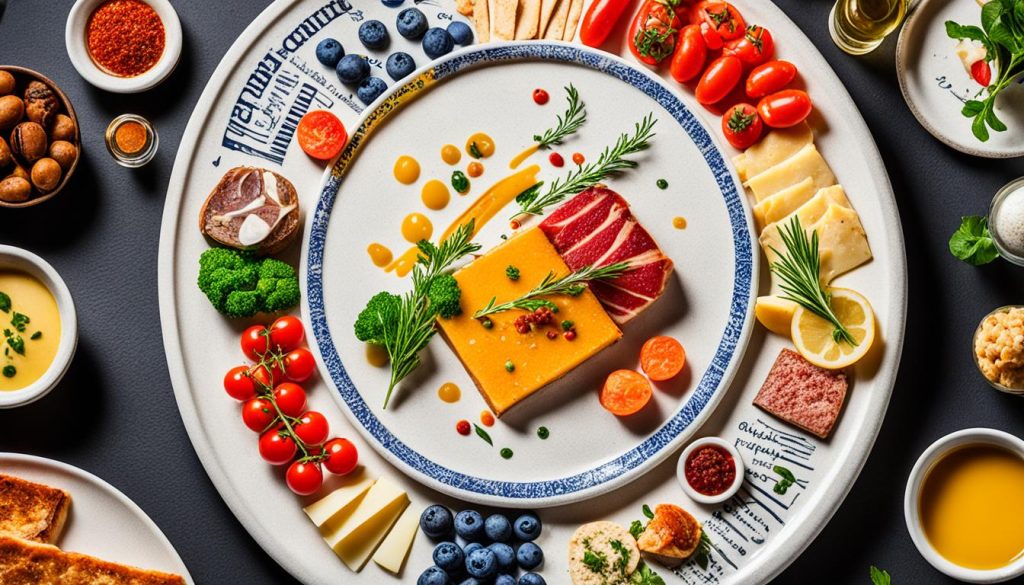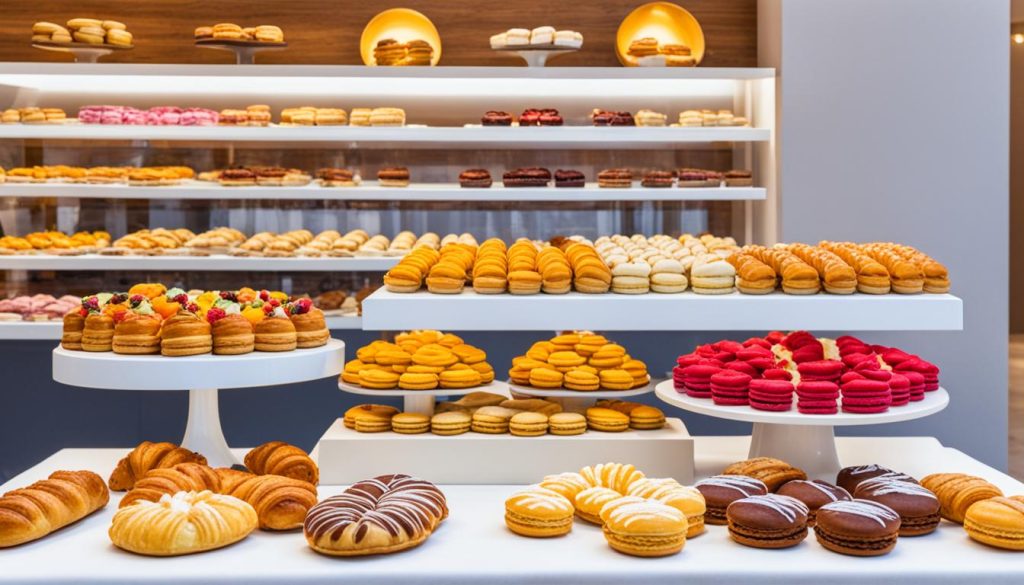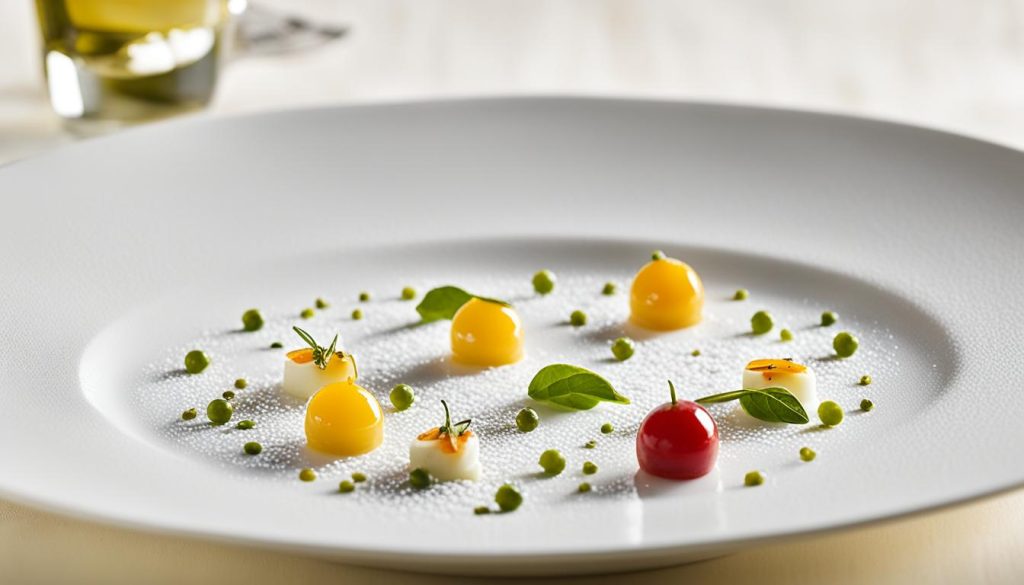Welcome to a delicious journey into France’s culinary heart. France is a top destination for food, captivating chefs and food lovers all over. Its cuisine, known for amazing flavors, is a sign of cooking excellence.
French food turns eating into an art. It mixes old practices with new ideas. This article will explore the rich world of French cuisine and its global impact.
Get ready to dive into famous French dishes and the world of haute cuisine. Learn the art of matching French wine with food. France’s cities and countryside offer unmatched food experiences.
This guide is for everyone who loves food, wants to cook better, or is just curious. It will take you deep into the world of French culinary art.
- France has a renowned culinary art culture that is celebrated worldwide.
- French cuisine combines rich traditions with innovative techniques.
- French culinary arts have had a significant influence on global gastronomy.
- Exploring French cuisine offers a delightful journey for food lovers and travelers.
- This guide will provide insights and resources to embrace French culinary art.
The Origins of French Cuisine
French cuisine is famous all over for its class, refinement, and deep tastes. To really understand France’s famous cooking skills, we must explore its beginnings. French food has changed a lot over time. It’s been shaped by different areas, cultures, and big historical moments.
The Influence of Ancient Gaul
The Essence of Haute Cuisine
Haute cuisine is the peak of culinary art and sophistication. It comes from a French term that means “high cooking.” It’s seen as the top achievement in the food world.
It mirrors centuries-old French culinary traditions and skills. France is known as the culinary heart of the world thanks to this. This style focuses on perfection, attention to detail, and high-grade ingredients.
Haute cuisine is known for its complex tastes, fine techniques, and detailed presentation. Chefs craft each dish carefully, showing their creative skill. These dishes are more than just food; they’re art that pleases the senses.
To reach top quality, chefs follow strict rules and principles. They choose the freshest ingredients and use classic French techniques. The aim is to make a dining experience that really stands out.
Haute cuisine elevates simple ingredients into something amazing. Ingredients like foie gras and truffles are picked for their excellence. This makes sure every bite is full of flavor.
The Pillars of Haute Cuisine
Haute cuisine is built on four key pillars:
- Technical Mastery: It requires great skill and attention to detail. Chefs train for years to learn the complex techniques needed.
- Flavor Pairing: Matching flavors is crucial. Chefs choose ingredients that go well together, making each dish taste perfect.
- Presentation: How food looks is very important. Chefs plate their dishes carefully, focusing on color, texture, and placement.
- Innovation: Despite its traditional roots, haute cuisine is all about new ideas. Chefs experiment to find new ways to amaze those who dine.
The true essence of haute cuisine is in how it transforms food into an amazing experience. It shows off the passion and hard work needed to achieve such refined cooking.
French Culinary Traditions
French cuisine is celebrated worldwide for its delicious flavours and skilled techniques. It’s rooted in a deep history of culinary traditions, passed down through families. These practices showcase the local specialties and stress the use of fresh ingredients.
French cooking is known for its focus on terroir, which means the way a place influences its food. Chefs in France prioritize ingredients from local farms to ensure quality. Each region, whether Provence or Normandy, offers unique culinary treasures.
French chefs are masters of traditional cooking techniques, like braising and roasting. They also use modern methods, such as sous vide. Their skill, along with an eye for detail, makes their dishes a feast for both the eyes and palate.
Regional Specialties
In France, regional dishes reflect local cultures and ingredients. For example, Alsace is famous for choucroute garnie, a rich sauerkraut dish. Provence loves its ratatouille, and Lyon is known for delicacies like coq au vin.
To highlight French cuisine’s variety, here’s a table of iconic dishes:
| Region | Specialty Dish |
|---|---|
| Brittany | Crêpes and galettes |
| Normandy | Camembert cheese |
| Provence | Bouillabaisse |
| Alsace | Tarte flambée |
| Burgundy | Boeuf bourguignon |
These dishes do more than just taste great. They share the rich culture and history of their regions. They show how important culinary traditions are in celebrating France’s diverse flavours.
The Role of French Chefs
French chefs are known the world over for their top-notch cooking skills. They’re crucial to the world food scene. Their skill in the kitchen, aim for perfection, and new ideas have pushed French food to new heights.
In top culinary schools, they get tough training. They learn high-level cooking techniques and how to come up with new dishes. Places like Le Cordon Bleu in Paris and Institut Paul Bocuse in Lyon are famous for training top chefs.
French chefs have a big impact outside France too. They’ve helped shape food globally, introducing new tastes and cooking methods. From classic sauces to pastry-making, their mark on world food is clear.
The French Chef’s Signature
French chefs pay close attention to every detail. Each dish is an art, blending tastes, textures, and looks. They turn simple ingredients into amazing meals.
They use only the best seasonal and local products. This makes their food tasty and shows off the area’s products. These chefs also honour cooking traditions while adding their own touch.
They’re not afraid to try new things in the kitchen. Their knowledge lets them mix old traditions with new ideas. This keeps their meals exciting and fresh for diners.
The Legacy of French Chefs
Their legacy is evident in Michelin-starred restaurants worldwide. Their drive and passion have inspired chefs to keep improving. They aim for the highest culinary standards always.
French chefs also share their skills in cooking contests and global projects. They promote French food worldwide, teaching chefs from different cultures.
Overall, French chefs are vital in food around the world. They combine skill, creativity, and a drive for perfection. Their work continues to inspire chefs globally, keeping French cooking at the top of culinary innovation.
Iconic French Dishes
![]()
French cuisine is known for its delicious flavors, careful methods, and beautiful look. From Paris to Provence, iconic dishes have won hearts worldwide. These meals display France’s culinary skills, cultural depth, and gastronomy love.
Coq au Vin is a cherished French dish. It’s a stew with chicken, red wine, and herbs from Burgundy. Here, the chicken is cooked in wine sauce, making it tasty and filling. Enjoy it with fresh bread.
Bouillabaisse comes from Marseille and is a classic fish soup. It uses mixed fish and is flavored with saffron, garlic, and tomatoes. Served with garlic chili mayo and toast, it showcases Mediterranean tastes.
Ratatouille is a lively stew made with fresh French vegetables. Eggplant, zucchini, bell peppers, and tomatoes are cooked slowly. This dish from Provence highlights the simplicity and finesse of French cooking. Ratatouille can be a main or a side dish.
These dishes, including Coq au Vin, Bouillabaisse, and Ratatouille, define French culinary tradition. Each meal has its own story and reflects a part of French culture. They continue to inspire cookers and please diners all over.
| Dish | Origin | Main Ingredients |
|---|---|---|
| Coq au Vin | Burgundy | Chicken, red wine, herbs |
| Bouillabaisse | Marseille | Fish (sea bass, monkfish, shellfish), saffron, garlic, tomatoes |
| Ratatouille | Provence | Eggplant, zucchini, bell peppers, tomatoes |
French Wine and Food Pairing
Exploring French cuisine is not complete without focusing on wine and food pairing. French gastronomy and wine have evolved together over centuries. France stands out for elevating this art to new levels.
Known worldwide, French wines excel in quality and variety. Each variety, from light whites to rich reds, reveals the uniqueness of its area. It makes the dining experience richer. For a deep appreciation of French meals, it’s key to know how wines match with food.
French wines pair amazingly with different meals. Light seafood and salads go well with a crisp Sauvignon Blanc from the Loire Valley. A Burgundy Chablis also matches, offering a refreshing taste. The acidity of these wines balances the richness of food nicely.
For white meats or creamy dishes, Burgundy’s medium-bodied Chardonnay is perfect. Its buttery notes work well with the dish’s richness. This enhances the whole meal.
Red meats and hearty dishes are great with Bordeaux wines from France. Their strong tannins and rich tastes match beef or lamb excellently.
For those keen on French food, here’s a guide on wine regions and their food pairings:
| Wine Region | Recommended Food Pairings |
|---|---|
| Burgundy | Roast chicken, creamy sauces, mushroom dishes |
| Bordeaux | Beef, lamb, strong cheeses |
| Rhône Valley | Grilled meats, stews, Mediterranean cuisine |
| Champagne | Oysters, caviar, light seafood dishes |
| Loire Valley | Goat cheese, white fish, shellfish |
Discovering French wines means exploring a realm of flavors for food pairing. The right wine transforms a meal, whether it’s a simple bistro or a grand feast. It turns dining into an unforgettable experience.
The Influence of French Cuisine on Global Gastronomy

French cuisine has had a major effect on global food traditions. It has shaped how chefs cook around the world. The beauty and skill of French cooking attract food lovers everywhere. This has led to French cooking methods and dishes being used worldwide.
French cooking techniques are very important. They include making stocks and sauces and cutting food precisely. These methods have become key in many cuisines around the globe. Chefs everywhere use French techniques like sautéing and flambéing. This adds French flair to their dishes.
French cuisine’s impact goes beyond techniques. French cooking words are used in kitchens all over the world. Words like mise en place and flambé help chefs communicate better. This shows how French culinary language has spread.
Restaurants inspired by France are popular in many places. They range from fancy dining spots to casual bistros. These eateries let people enjoy French food’s artistry and elegance. French-inspired restaurants show how much the world loves French cuisine.
French dishes and ingredients have mixed into other food traditions. For instance, French bread and pastries are now common in bakeries everywhere. French sauces, like béchamel and hollandaise, enhance dishes globally. They add richness and taste.
The role of French cuisine in world gastronomy is huge. It has improved and refined cooking practices everywhere. French techniques, words, and dishes are key in global cuisine. Chefs and food fans keep being inspired by France’s culinary traditions. French cuisine’s impact is sure to last.
Gastronomic Tourism in France
France’s cuisine is world-famous, drawing visitors for gastronomic adventures. Its variety of regional dishes and long history of culinary art offers an exciting experience. Visitors from everywhere come to enjoy exceptional meals.
In France, gastronomic tourism takes you from cozy village eateries to exciting city restaurants. Lyon, for instance, is famed as France’s food capital. It boasts top-class restaurants and quaint bouchons that serve delicious local foods.
Exploring local food markets in France is a must for food lovers. The Marché de Rungis in Paris is the biggest of its kind. Here, visitors can see fresh veggies, cheeses, and meats. It’s a great way to learn about France’s regional specialities and meet the people behind them.
In France, you can find real culinary adventures in its regions. You might go looking for truffles in Provence or taste wine in Bordeaux. Or, try cooking traditional dishes in Normandy. These activities help tourists connect with France’s food traditions and its people.
France also hosts food festivals that highlight its culinary culture. These events feature local dishes, chef demos, and allow visitors to dive into French food. The Lyon Street Food Festival, for example, celebrates the variety of French street food with food trucks and booths.
Top Culinary Destinations in France
| Destination | Culinary Highlights |
|---|---|
| Lyon | Michelin-starred restaurants, local bouchons serving Lyonnaise dishes |
| Paris | World-renowned patisseries, gourmet food markets |
| Bordeaux | Wine tasting experiences, exceptional vineyards |
| Marseille | Fresh seafood, vibrant street food scene |
| Alsace | Quiche, sauerkraut, and other Alsatian specialties |
Exploring France through its cuisine offers a chance to make unforgettable memories. Whether it’s a meal in a top-notch restaurant, browsing a bustling market, or taking a cooking class. These experiences are sure to impress.
French Patisserie and Boulangerie

Discover the sheer delight of French patisserie and boulangerie. In France, making pastries and bread is an art form that shows off elegance, precision, and taste like no other.
Delight in a range of exquisite pastries, beautifully made. Enjoy the buttery taste of croissants and the light, colourful macarons. Each bite is a mix of wonderful tastes and textures. Imagine tasting fresh fruits, chocolate, or silky crème atop these delicious treats. They are proof of true culinary skill.
In France, boulangeries take pride in baking bread the traditional way. You’ll find crusty baguettes, soft brioches, and dense sourdough loaves. The smell of fresh bread in the air is inviting. A bite of a warm baguette will make you feel like you’re walking through Paris.
The Masters Behind the Magic
The magic of French patisserie and boulangerie comes from its skilled artisans. Famous chefs and local bakers alike share their passion and skill with the world. They’ve spent years perfecting their craft.
This culinary art demands a keen eye for detail and thorough knowledge of ingredients. Every pastry and loaf is crafted with care. The result? Flavours and textures that amaze and delight all who taste them.
Exploring French Delicacies
A visit to France must include discovering its patisseries and boulangeries. Whether in Paris or Provence, pastry shops and bakeries abound. They’re ready to tempt you with their creations.
Experience the tarte tatin, an upside-down apple tart, or the creamy delight of crème brûlée. And don’t miss the mille-feuille, with its pastry and custard layers. These are just a few of the treats awaiting you.
The Perfect Pairing: Coffee and Pastries
Talking about French patisserie and boulangerie means also talking about coffee. A pastry and a cup of coffee together are pure bliss.
French coffee is taken seriously and comes in many forms. Try an espresso, café au lait, or café crème with your pastry. This duo creates an unforgettable taste experience.
| Patisserie | Flavor Profile |
|---|---|
| Croissant | Buttery, flaky, and delicately sweet |
| Macaron | Crisp meringue shells with creamy fillings in a variety of flavors |
| Tarte Tatin | Caramelized apples on a buttery pastry crust |
| Éclair | Soft choux pastry filled with flavored creams and glazed with chocolate |
| Mille-Feuille | Layers of flaky pastry, custard, and glaze |
If you ever visit France, take time to explore its patisserie and boulangerie world. Let your taste buds explore the artistry and flavours. These treats are celebrated globally. Bon appétit!
Culinary Festivals and Events in France
France is famous for its amazing food and vibrant culinary festivals. These events attract food lovers from all over the world. They are a place for chefs and food producers to show off French cuisine, regional foods, and local produce.
The “Salon International de la Gastronomie de Lyon” is one of these exciting festivals. It takes place in Lyon, the food capital of France. Here, top chefs, local food makers, and food experts come together. Visitors can try out lots of gourmet dishes, learn about traditional recipes, and see live cooking shows by famous chefs.
The nationwide “Fête de la Gastronomie” is another big event. It happens in different places across France. The goal is to celebrate and teach people about French food traditions. There are street food markets and unique gourmet experiences for food fans of every age.
If you love seafood, you should not miss the “Fête de la Mer” in Saint-Malo. This festival celebrates seafood. You can try fresh oysters, mussels, shrimp, and more. Plus, it’s all set in a beautiful coastal area.
France also hosts many wine and food festivals that show off the country’s amazing winemaking. The “Fête des Vendanges” in Montmartre, Paris, is very famous. It marks the grape harvest season with wine tasting, tours of vineyards, and delicious food. It’s a chance to enjoy Montmartre’s magical atmosphere and taste great wines.
In addition to these famous events, there are lots of market fairs and local food celebrations all year round. The “Foire aux Fromages” in Rocamadour celebrates local cheeses. The “Fête de la Truffe” in Périgod is all about the region’s truffles. Each event highlights the special food of the area.
Attending these festivals is not just about great food. It’s also a way to support local farmers, learn about traditional cooking, and discover new tastes. Whether you’re a big food fan or just interested in French cuisine, these events will make you love France’s food even more.
Culinary Festivals and Events in France:
| Festival | Location | Date |
|---|---|---|
| Lyon Gastronomy Fair | Lyon | February/March |
| Fête de la Gastronomie | Throughout France | September |
| Fête de la Mer | Saint-Malo | July |
| Fête des Vendanges | Montmartre, Paris | October |
Trends and Innovations in French Cuisine
French cuisine is known for its elegance and deep culinary roots. It keeps growing, combining old and new trends. Recent years have seen a blend of classic and modern styles, changing French food culture. This part looks at the latest trends and major innovations changing French cooking.
The Rise of “Bistronomy”
The trend of “bistronomy” has become popular lately. It merges “bistro” and “gastronomy.” Bistronomy creates a new French food style, mixing fine dining and casual eating. Innovative restaurants serve creative and high-quality meals in a friendly setting. This makes great dining available to more people.
Bistronomy displays the creativity of French chefs. It meets the evolving tastes and expectations of customers. This trend mixes tradition with innovation, offering French cooking in an easy-to-enjoy way.
An example is “Le Comptoir du Relais” in Paris. Led by famous chef Yves Camdeborde, this top bistronomy spot is celebrated worldwide for its bold and inventive dishes. It highlights the growth of this dining trend.
Exploration and Revival of Regional Specialties
There’s also a growing interest in regional French food. Chefs are bringing back old regional recipes and adding a modern twist. This celebrates France’s varied culinary history.
In Burgundy, known for its culinary heritage, dishes like “Boeuf Bourguignon” and “Escargots de Bourgogne” are making a comeback. Chefs are giving these classics a new look by using surprising ingredients and improving the cooking methods.
Rediscovering and updating regional dishes highlights France’s rich food culture. It keeps traditional recipes alive while adding a fresh, contemporary approach.
The Emergence of Innovative Cooking Techniques
New cooking methods have also transformed French cuisine. Chefs are exploring innovative ways to boost flavor and texture, creating unique dining experiences.
“Sous vide” cooking is one innovation, where food is sealed in bags and cooked in a water bath at exact temperatures. This technique cooks food perfectly, enhancing its taste and tenderness.
Molecular gastronomy is getting more popular, too. Chefs use science to make artistic and groundbreaking dishes. Techniques like spherification and foams turn meals into a feast for the senses.
These new cooking methods not only show the skills of French chefs but also bring a modern touch to classic dishes, making meals more exciting.
| Trends | Innovations |
|---|---|
| 1. Fusion of traditional and contemporary elements | New culinary concepts blending haute cuisine with bistros |
| 2. Exploration and revival of regional specialties | Revamped traditional dishes with a modern twist |
| 3. Emergence of innovative cooking techniques | Sous vide, molecular gastronomy, and more |
Embracing French Culinary Art – Tips and Resources
For those keen to explore French cuisine, many resources can help. Start by diving into the world of French cookbooks. Titles like “Mastering the Art of French Cooking” by Julia Child and “The French Laundry Cookbook” by Thomas Keller are great. They teach you traditional cooking methods and famous recipes.
But reading alone won’t make you a master chef. Why not take a culinary class? Culinary schools offer everything from brief workshops to advanced courses. Led by skilled chefs, these classes give you practical skills. You’ll also meet fellow food lovers and share cooking tips.
Today, online resources are essential for learning cooking. Websites like Bon Appétit, Taste of France, and Epicurious are packed with French recipes and videos. They offer tutorials, articles, and tips to improve your cooking. It’s a great way to learn new techniques at home.
Learning French cooking is an adventure of passion and patience. Start with easy recipes like French omelette and gradually try more complex ones. Embrace each step of your culinary journey. With determination and the right resources, you’ll master French cuisine and impress with your skills.
















